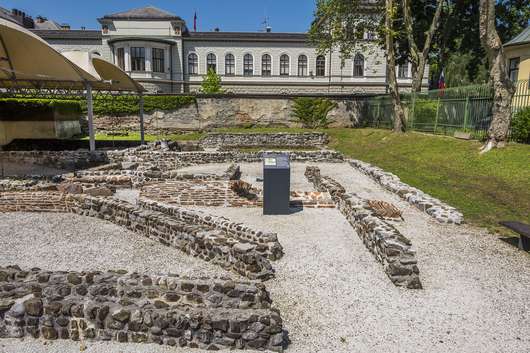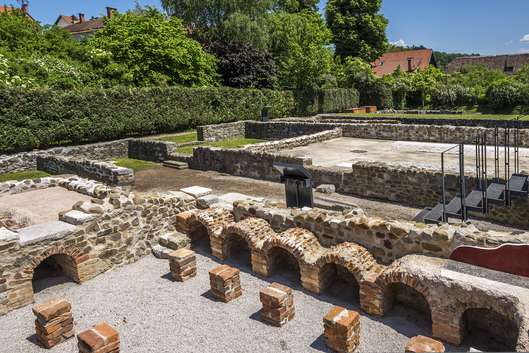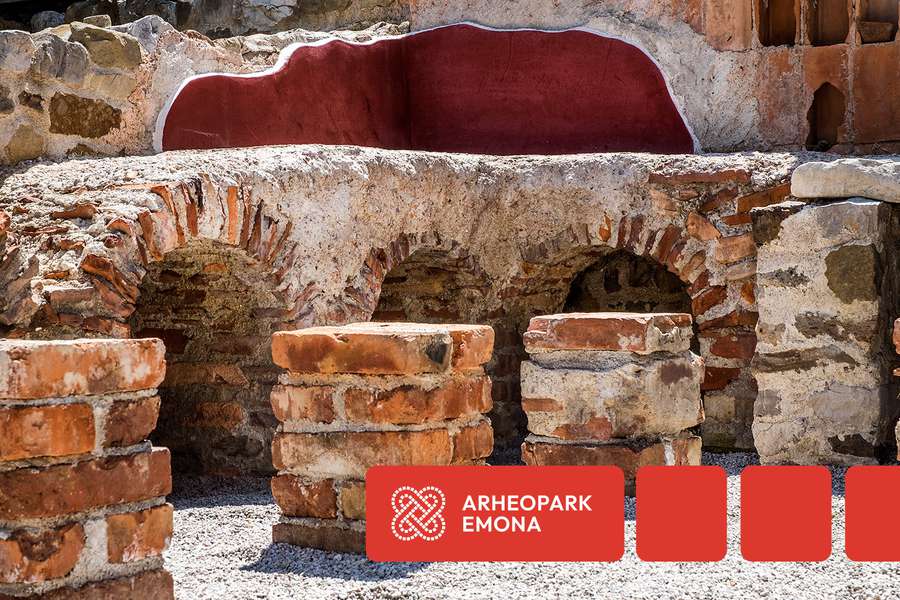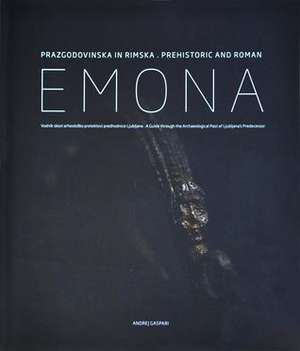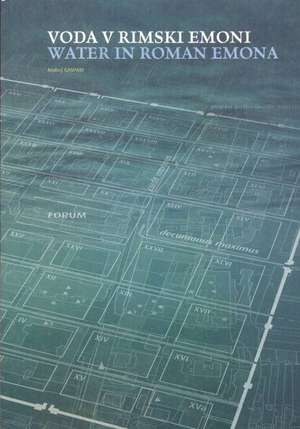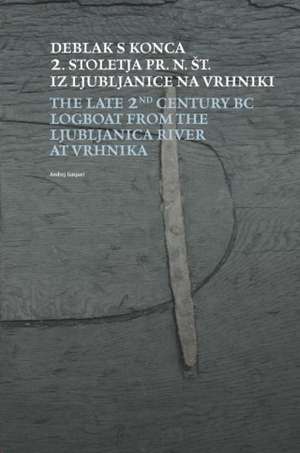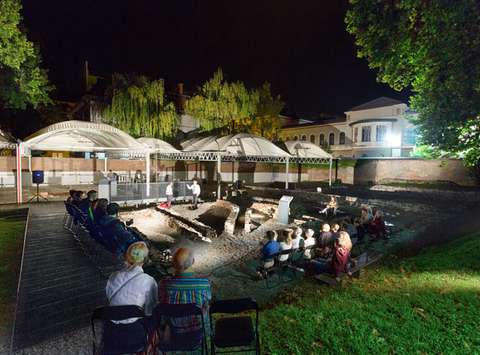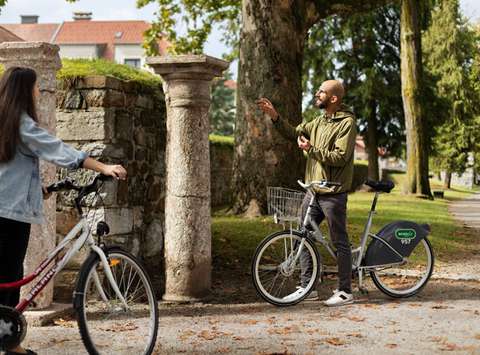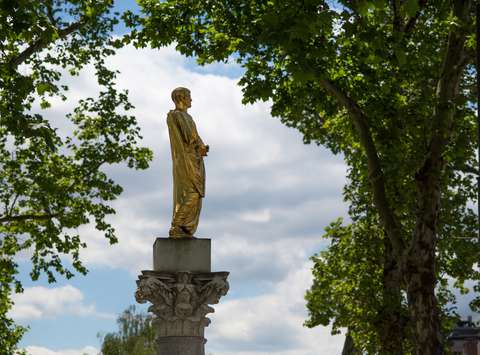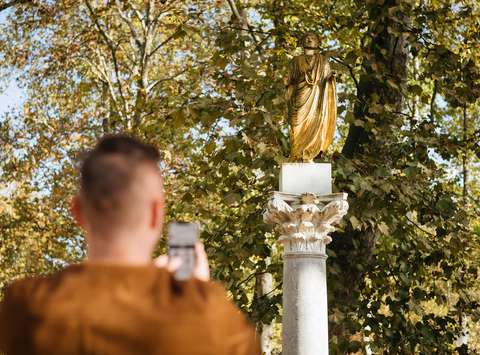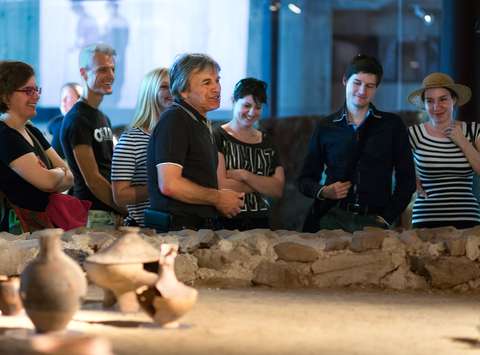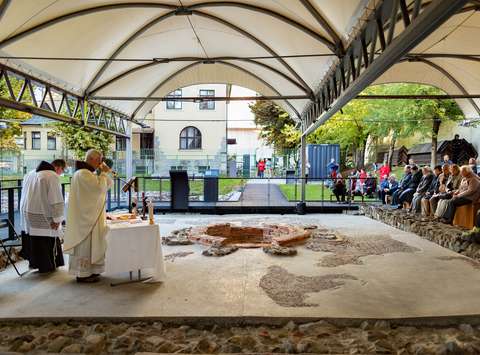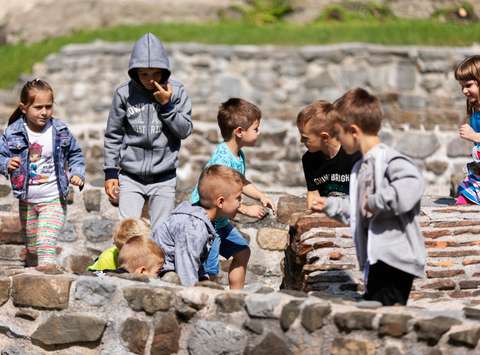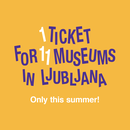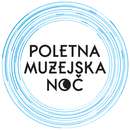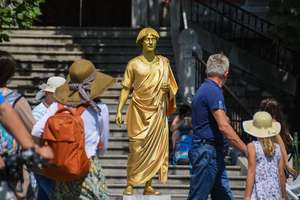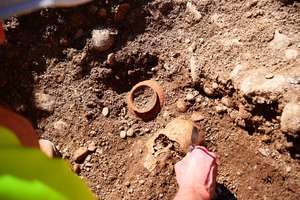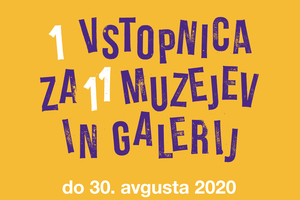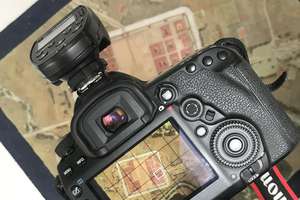Archaeological park Emona
A special place in Ljubljana's history is reserved for Roman Emona, the traces of which have been preserved in the very centre of the city.
Welcome to a trail tracing the 2000-year-old heritage of Emona. A walk through modern Ljubljana can take you further than you think! It takes you to the time of Emona, a city brimming with life between the first century and early sixth century.
Take a trail tracing the 2000-year-old heritage of Emona. Discover the ancient town’s mysteries along a circular trail of Roman Ljubljana. Visit Emona. Enter a house from the Roman period. Locate Ljubljan's first baptistery. Touch a Roman wall. Find out how the inhabitants of Emona lived, how they defended themselves, how their heating worked, where they spent time together, which roads they travelled on and where they said farewell to their loved ones.
Take a trail tracing 10 sites of the town and see what it was like from the 1st to the 6th century. Come visit the Emonan House and the Early Christian Centre archaeological parks and Roman wall which, as oases in the middle of the city, offer the most beautiful remains from Roman Emona.
Tickets including a map and a family guide for the Roman Trail of Ljubljana are available in the City Museum of Ljubljana, Gosposka 15.
Guided tours:
Every last Sunday of the month at 10:00 AM: A walk through the Mosaic of Ancient History. Join experienced guides and discover the stories of this hidden ancient gem on a circular route through Archaeological Park Emona. We start at the City Museum of Ljubljana, Gosposka 15.
Emonan House
The Emonan House archaeological park is situated at Mirje, on the edge of the present-day centre of Ljubljana. It is here that archaeological excavations uncovered a Roman residential building.
During the excavations in Emonan House park (previously Jakopič Garden) which were underway in the 1963-1964 period a residential building that once stood in the city of Emona was discovered. Today, the park presents the remains of this building dating from the late 4th and early 5th centuries. Judging by the high-quality building finishes and utilities (floors, mosaics, heating), the building was home to a wealthy and respectable Roman family.
The central dwelling place was what is termed a summer room and its floor was made up of a two-coloured geometrical mosaic; only the rich could afford mosaics at that time. On the other side, the passage led to what is termed a winter room, featuring a preserved system of hypocaust heating. From the heating place located in the neighbouring room, hot air was channelled under the floor of the winter room; apart from the floor, the walls were also heated by hot air. In order to provide for thermal conductivity, the walls were built from hollow bricks. The building was also connected to the sewage system: waste water left the building through small drains covered by stones into a larger collection sewage drain (sewer) flowing below the nearby road and leading to the Ljubljanica River.
ARCHEST Project. Co-founded by the Creative Europe Programme of the European Union.
Author: Uroš Hohkravt / Concept by: Bernarda Županek Ph.D, MGML
Early Christian Centre
The Early Christian Centre archaeological park is situated on Erjavčeva cesta, right opposite the Cankarjev dom cultural centre. The archaeological excavations conducted here unearthed a Roman residential building. Like with the majority of Emonan houses, it was built at the beginning of the 1st century A.D. During the nearly 500 years of its existence it was rebuilt several times. The first major rebuilding was undertaken in the early 4th century. On that occasion, the floors were renovated, the hypocaust heating was arranged and three small pools were added, suggesting that the building might have been turned into private baths.
In the second half of the 4th century, one section of the house was rebuilt as an early Christian chapel. However, a major alteration occurred at the beginning of the 5th century when a rectangular baptistery with a small pool in the centre intended for baptising was built alongside the central courtyard. The baptistery floor is covered in a multi-coloured mosaic with inbuilt inscriptions bearing the names of the Emonans who had donated the funds for its assembly. There was a covered portico featuring a coloured mosaic leading to the baptistery. The mosaic had an inbuilt inscription with the name of the builder, Archdeacon Antioha. This shows there was a strong community of early Christians in Emona at that time. Its existence is also confirmed by written records which refer to Emonan bishops.
ARCHEST Project. Co-founded by the Creative Europe Programme of the European Union.
Author: Uroš Hohkravt / Concept by: Bernarda Županek Ph.D, MGML
Roman Wall
The Roman town of Emona existed from the 1st to the early 6th century. The town, with a rectangular layout, had a wall with towers and four main gates.On the northern, western and southern sides, the town wall had a double moat.
The southern section of the wall, known today as the Roman wall, was renovated in the 20th century by Jože Plečnik, an internationally renowned architect whose works created after 1921 left an indelible mark on the whole of Ljubljana.
About Emona
Emona (Colonia Ivlia Aemona in Latin) was a Roman settlement in the centre of today's Ljubljana. Its name is probably of Celtic, pre-Roman origin. The area of Emona was at first under the jurisdiction of the Cisalpine Gaul province, while it later merged into Italy itself.
The Ljubljana basin had already been populated before Roman times and already during prehistory important trade routes from the Apennine Peninsula, the Baltic Sea and the Balkans ran through it.
Sozomen, a Byzantine ecclesiastical historian, attributed the founding of the first settlement in the area of Emona to Jason and the Argonauts in the 13th century BCE. They sailed and navigated up the Sava River to a place where they wintered and then made their way to the land of Italics on the Ljubljanica River and on foot. After the Roman conquest in the second half of 1st century BCE a military camp was most likely constructed under Castle Hill. By the year 15 CE the Romans then constructed a rectangular town, protected by mighty stone walls and a three-sided double trench, which had all the characteristics of a Roman castrum. This town, built in the area between the Ljubljanica and Šišenski hrib hill, was founded with the intention of reinforcing the hinterlands after the Illyrian revolts. Its first settlers were colonizers from Italy and Gaul, their slaves and Roman army veterans.
Emona held an important role in the defence of Italy between the 2nd and 4th century. During the 2nd century the city suffered due to Marcomannic Wars and plague, while in 238 its own citizens burned it down and abandoned it to prevent the army of the usurper Maximinus Thrax to make camp there. In 408 Emona was visited by Alaric I, king of the Visigoths. As the Byzantine magister militium he was on a mission to retake Italy for the Byzantine Empire and it is likely that bribes saved the skins of Emonans.
In 452 the city was ravaged and partially destroyed by the Huns. Emona was impoverished but lived on. At the end of the 5th and start of the 6th century the city was ruled by the Visigoths, who left only a few tracks behind. During the restless times of Late Antiquity and the Migration Period in the 6th century people started taking refuge in remote and inaccessible locations (Sveti Lovrenc on the Polhograjska gora hill, Molnik, Moreček, Golo) and migrating to coastal cities, especially Koper, Piran and Novigrad, until the last citizen left Emona.
You can read more about Emona on Wikipedia.
Location
Information and reservations:
T: +386 1 2412 500
T: +386 1 2412 506
E- mail: info@mgml.si, prijava@mgml.si
Opening hours
Open from Tuesday to Friday between 2:00 PM and 6:00 PM, and on Saturdays and Sundays, between 10:00 AM and 6:00 PM.
Tour reservations and additional information by phone +386 1 2412 506 or e-mail prijava@mgml.si.
Tickets
Adults: € 4,00
Reduced*: 2,50 €
Family: 10,00 €
Free: ICOM, PRESS, SMD, URBANA Tourist Card holders, disabled companions, licensed tourist guide.
We recommend purchasing a combo ticket for the Ljubljana City Museum and the Emona Archaeopark.
Adults: € 10,00
Reduced*: 8,00 €
Family: €22.00
The ticket includes a visit to the Emona Archaeopark, as well as a visit to all current exhibitions at the Ljubljana City Museum.
Guided tour of the Emona Archaeopark on the published dates (approx. 120 min):
Adults: € 9.00
Reduced*: € 7.00
Family: 18,00 €
Important: With your ticket you also get access to the Ljubljana City Museum with all current exhibitions.
Guided tour of the Archaeopark on a date of your choice (book at prijava@mgml.si)
Group of up to 7 persons: 70,00€,
Group of up to 7 persons, discounted*: 55,00 €
Group of 8 or more persons: 9,00 €/adults, 7,00 €/reduced*
* seniors over 60, students, children and young people under 19, unemployed, disabled
News
Heritage of Emona connects to the heritage of the Danubian provinces of the ancient Roman Empire.
Ljubljana museums’ collective special offer for the summer: 1 ticket to 11 museums
On Museums on a Summer Night, we are opening our doors for visitors.
In the beginning of March, the ZRC SAZU Institute held the 10th Grošelj Symposium, which brings Antiquity and Humanistic Studies closer to contemporary audiences. Bernarda Županek, our curator for Antiquity, and Alenka Miškec, her colleague from the National Museum of Slovenia, held an interesting presentation of a Roman gemstone with an engraved ship at the symposium.
Events
